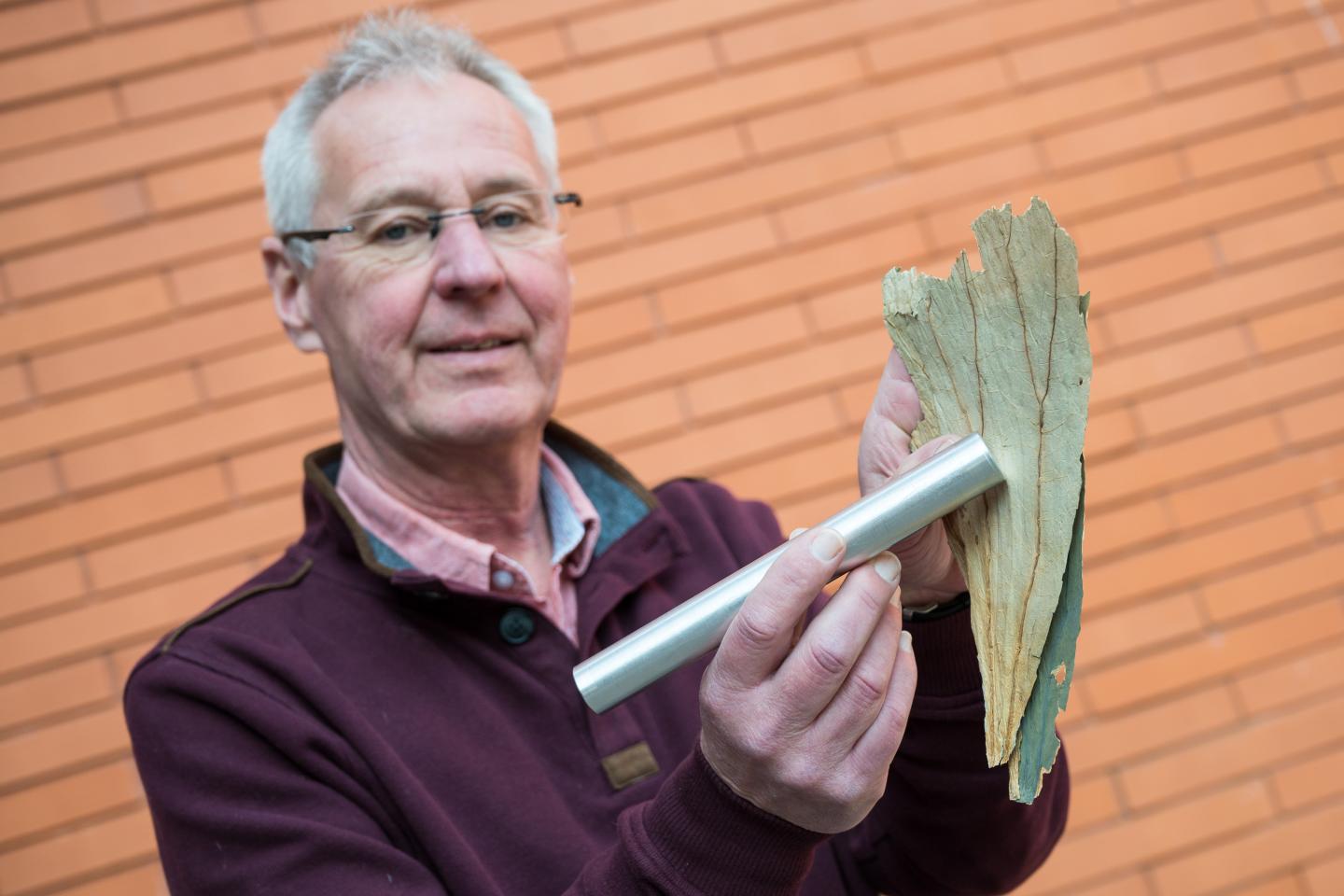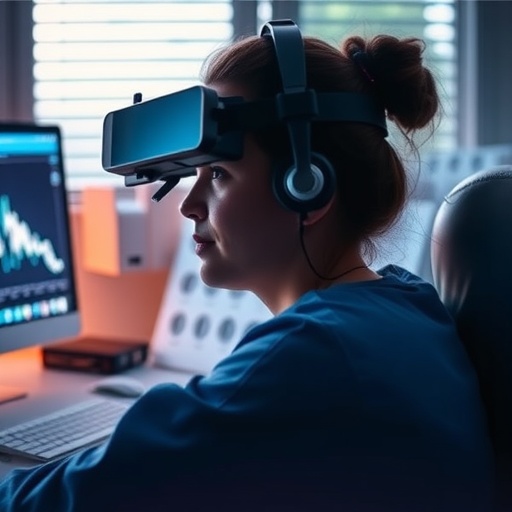New diagnostic options

Credit: Oliver Dietze
Physicists at Saarland University have developed magnetic field sensors that are breaking sensitivity records and opening up a whole range of potential new applications, from non-contact measurements of the electrical activity in the human heart or brain to detecting ore deposits or archaeological remains deep underground. Professor Uwe Hartmann and his research team have developed a system that allows them to detect weak magnetic signals over large distances in normal environments (no vacuum, no low temperatures, no shielding), despite the presence of numerous sources of interference. Their system can detect signal strengths far below a billionth of a tesla – about a million times smaller than the Earth’s magnetic field – and can be used to detect biomagnetic signals in the human body or geophysical phenomena.
The research team will be exhibiting at Hannover Messe from April 1st (Hall 2, Stand B46) and are looking for partners with whom they can develop their technology for practical applications.
If doctors want to examine a patient’s heart to see whether it is beating irregularly, they first need to attach electrodes to the patient’s chest, wrists and ankles. The same is true when trying to measure the electrical activity of the brain. The patient first has to be wired up before the electrical activity of their brain can be recorded. But when things need to happen fast, this can mean that medical staff lose valuable time. It would be a lot easier if a device similar to a metal detector was available that could be swept over the patient’s body or head but would still deliver reliable results. Up until now, non-contact medical diagnostic procedures have failed because they are simply not suitable for everyday use. Sensors that are sensitive enough to measure the biomagnetic fields produced by the human body need to operate in very carefully regulated environments. They need to be well shielded from external sources of interference, have to be operated at impractically low temperatures of below -200 °C or require a vacuum.
Now, however, Professor Uwe Hartmann and his team of experimental physicists at Saarland University have succeeded in developing magnetic field sensors that can operate under normal ambient conditions while still being able to detect very low-level signals, such as the weak biomagnetic fields produced by many of the body’s functions. ‘You could say the precision of our technique is like being able to locate a grain of sand in a mountain range. We can detect over relatively large distances magnetic fields that are approximately a million times weaker than the Earth’s magnetic field – just a few picotesla, that is a millionth of a millionth of a tesla,’ explains Uwe Hartmann. So far, sensors working under normal ambient conditions have been able to detect magnetic fields that are about a thousand times smaller than the Earth’s magnetic field.
The real challenge, however, was not the barely detectable magnitude of the signals themselves. ‘The main problem when measuring these tiny signals in a normal environment is being able to cleanly separate the signals from the multitude of interference signals that are inevitably present,’ says Hartmann. There are all sorts of factors that generate noise or that falsify the weak signal that the physicists are interested in. Sources of interference include the Earth’s magnetic field, electrical devices, moving traffic, signals from other organs in the body or even from solar storms. Hartmann’s research group has been working for years on magnetometers (magnetic field sensors) and they have successfully developed these devices for a whole range of applications. ‘Over the last few years, we have managed to boost the sensitivity and selectivity of our magnetometers. The sensitivity that our sensors now demonstrate is the result not only of our continuous sensor-development work, but particularly the improvements in our data processing software,’ he explains.
Hartmann and his team have been involved in several projects where their focus was on filtering out interference signals from measurement data. The researchers in Saarbrücken have, for example, developed a smart sensor cable in which the magnetometers are connected to one another in a network. A number of these systems are currently being trialled as components in airport traffic management systems. In another application, the sensors are used for remote monitoring of perimeter fencing. In this case, the system has to be able to distinguish and identify all of the different factors that cause measurable changes in the magnetic field. The research team therefore carried out large numbers of tests in which they simulated changes to the magnetic field, such as those that occur when the fence vibrates or when it is struck, and assigned the resulting signal patterns to the corresponding sources. The physicists have modelled the signal patterns mathematically, translated the results into algorithms and used these to program the analyser – a process that is being continuously refined as increasingly detailed data becomes available. ‘We use this information to teach the system and to continuously expand its capabilities. It can recognize typical signal patterns and automatically assign them to different sources of interference. We are now in a position where we can assign measurement data and signal patterns very precisely to their respective causes,’ explains Hartmann.
While the work being carried out by Professor Hartmann and his team is in essence basic research, there are a wide range of potential applications for these highly sensitive magnetometers. They could, for example, be used for diagnostic purposes in cardiology or neurology, where they could complement existing techniques such as ECG (electrocardiography) or EEG (electroencephalography). Another potential area of use is in geophysical sensing when searching for crude oil, mineral deposits or archaeological remains.
The research team will be showcasing their work at Hannover Messe where they will be looking for commercial partners, particularly companies in the medical technology sector, with whom they can develop their technology for practical applications.
The team will be demonstrating the sensitivity of their sensors in Hall 2 (Stand B46) by detecting surprising examples of magnetic objects in the local vicinity.
###
The research project has received funding from the European Union, the German Research Foundation (DFG) and the Federal Ministry of Education and Research (BMBF).
Press photographs are available at http://www.
German Version of this Press Release:
https:/
Contact for press enquiries:
Prof. Dr. Uwe Hartmann, Nanostructure Research and Nanotechnology Group, Department of Experimental Physics, Saarland University, Germany: Tel.: +49 681 302-3799 or -3798; Email: [email protected]
Dr. Haibin Gao Tel: Tel.: +49 681 302-3654; Email: [email protected]
Note for radio journalists: Studio-quality telephone interviews can be conducted using broadcast audio IP codec technology (IP direct dial or via the ARD node 106813020001). Contact: +49 681 302-2601 or -64091.
The Saarland Research and Innovation Stand is organized by Saarland University’s Contact Centre for Technology Transfer (KWT). KWT is the central point of contact for companies interested in exploring opportunities for cooperation and collaboration with researchers at Saarland University. http://www.
Media Contact
Uwe Hartmann
[email protected]
Original Source
https:/




